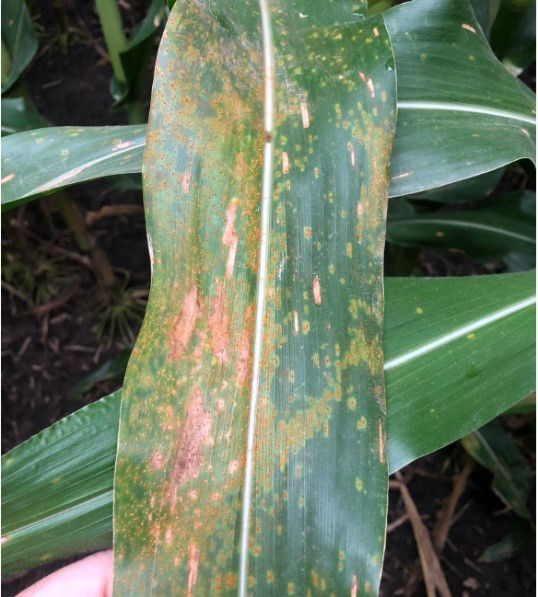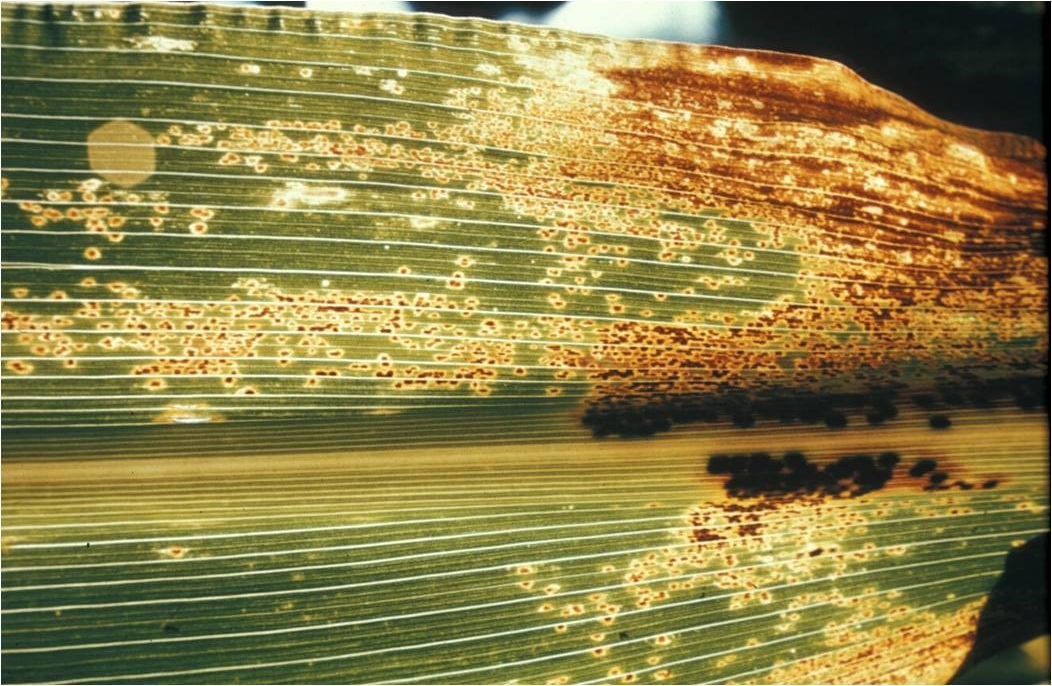12 MIN READ
Mid-Season Corn Disease Development
July 14, 2023
- Storms, overwintering disease inoculum, and temperatures influence what can infect corn between the seedling stage and grain fill.
- Crop management decisions are based on the identification and possible resolution of mid-season corn issues.
Gray Leaf Spot (GLS)
Diagnostic Characteristics: A fungus disease that causes small necrotic spots with halos that progress into rectangular blocks running parallel to leaf veins.
Scouting Window: Typically, two weeks prior to and two weeks after pollination. The disease has a two-week incubation period after infection.
Management:
In-season: Fungicide application at VT (tasseling) growth stage to R1 (silking) growth stage or earlier if lesions appear earlier in season.
Off season: Crop rotation and selection of corn products with good (or improved) GLS ratings, especially for fields with a history of GLS pressure.

Northern Corn Leaf Blight (NCLB)
Diagnostic Characteristics: A fungus disease that causes lesions that are long (1 to 6 inches, 2.5 to 15 cm) and elliptical, gray-green at first but then turn pale gray or tan. Under moist conditions, dark gray spores are produced, usually on the lower leaf surface, which give lesions a "dirty" gray appearance.
Scouting Window: Typically, two weeks prior to and two weeks after pollination.
Management:
In-season: Fungicide application at VT (tasseling) growth stage to R1 (silking) growth stage or earlier if lesions appear earlier in season.
Off season: Crop rotation and selection of corn products with good NCLB ratings, especially for fields with a history of NCLB pressure.

Southern Rust
Diagnostic Characteristics: A fungus disease that has circular to elliptical lesions with light green/yellow halos. Orange to red pustules develop on leaf surface. Infection can result from storms that move up from the south followed by wet and humid weather.
Scouting Window: Typically, two weeks prior to pollination and throughout grain fill. Pustule formation can occur earlier under ideal conditions, especially in late-planted corn. Infection before flowering causes the most risk of yield loss.
Management:
In-season: Foliar fungicides soon after the first few pustules are observed. Multiple sprays may be warranted in severely infected fields, but fungicide should not be applied on corn within two weeks of black layer. Fungicide should contain dual modes of action, including a strobilurin (trifloxystrobin) and triazole (prothioconazole).
Off season: Selection of corn products with excellent tolerance to Southern rust is important in areas at high risk for severe disease outbreaks. Early planting dates can help minimize the window in July where storms can carry the fungus from the south and temperatures are high and humid.

Common Rust
Diagnostic Characteristics: A fungus disease that starts symptom development with chlorotic flecks on the leaf surface. These soon develop into powdery, brick-red pustules. Pustules are oval or elongated, about 1/8 inch (3 mm) long and scattered sparsely or clustered together. The leaf tissue around the pustules may become yellow or die, leaving lesions of dead tissue. As the pustules age, the red spores turn black, so the pustules appear black.
Scouting Window: Typically, two weeks prior to pollination and throughout grain fill. Pustule formation can occur. Rust development is favored by high humidity with night temperatures of 65 to 70° F (18 to 21° C) and moderate daytime temperatures. The disease is usually more severe on seed corn.
Management:
In-season: It rarely reaches levels that cause yield loss in commercial corn products. However, there are fungicides available and are most beneficial on susceptible corn products, especially if applied early when few pustules have appeared on the leaves.
Off season: Selection of corn products with excellent tolerance to common rust are available.

Tar Spot
Diagnostic Characteristics: A fungus disease that infects the corn leaves and creates black spots called stroma. Tar spot lesions are hard, black, raised spots that are typically 1/16 to 3/4 in (0.15 to 2 cm) in diameter that cannot be rubbed off. Dew, lingering fogs, and rainy days provide extended leaf wetness durations that drive disease severity.
Scouting Window: Typically, tar spot has been observed most often during mid- to late grain fill (growth stages R3 (milk) to R6 (black layer); however, it has been observed shortly after pollination.
Management:
In-season: Foliar fungicides between the VT (tasseling) and R3 (milk) growth stages. Consider using the prediction program, Tarspotter (https://ipcm.wisc.edu/apps/tarspotter/).
Off season: Manage residue, rotate to other crops, and avoid highly susceptible corn products.

Physoderma Brown Spot
Diagnostic Characteristics: A fungus disease with symptoms usually appearing on mid-canopy leaves. Leaf lesions are numerous, very small (approximately 1/4 inch (6 mm) in diameter), round to oval, yellowish to brown in color, and usually occur in broad bands across the leaf. Dark purplish to black oval spots also occur on the midrib of the leaf.
Scouting Window: Corn is most susceptible to infection between V5 (five leaf stage) to V9 (nine leaf stage, tassel developing rapidly but not visible). It is more prevalent in wet growing seasons. A combination of light, free water, and warm temperatures, 75 to 85° F are needed for infection. Leaf infection occurs in the whorl when water is present for an extended time.
Management:
In-season: Generally, does not result in yield loss; however, some corn products are more susceptible than others. Foliar fungicides are available, but efficacy data are currently limited.
Off season: Promoting residue decomposition through tillage and rotating away from corn.

Bacterial Leaf Streak
Diagnostic Characteristics: A bacterial disease that infects corn leaves. Initial symptoms are tan, brown, or orange lesions that occur between the veins of the corn leaves. The lesions appear translucent with bright yellow halos, which when backlit, are easy to see extending from the lesions.
Scouting Window: Any stage of corn growth, observed as early as mid-June. It is more common in fields under continuous corn production, but it has been observed on corn following soybean, wheat, and fallow. Bacterial leaf streak occurrence appears to increase after overhead irrigation or rainfall during hot weather.
Management:
In-season: Sanitize equipment between fields.
Off season: Crop rotation to a non-host crop. Control weeds and volunteer corn as both may harbor the bacteria from year-to-year. Additionally, there are several grass weed hosts that may be alternative hosts.

Goss’s Wilt
Diagnostic Characteristics: A bacterial disease with water-soaked lesions with wavy margins, freckles inside lesions, ‘ooze’ or shiny appearance.
Scouting Window: Symptoms often become most visible and increase in severity after silking. Disease development is favored by warm (80° F) weather. Very hot (greater than 95° F) or cool (less than 70° F) temperatures may impede disease development. Goss’s wilt primarily infects leaves that have been wounded, such as by hail, sand-blasting, rain, wind, and strong storms.
Management:
In-season: Because it is bacteria, fungicides are not effective.
Off season: Resistant corn products are available. Crop rotation and tillage help reduce survival of pathogen.

Sources:
2022. Gray leaf spot of corn. Crop Protection Network. https://cropprotectionnetwork.org/encyclopedia/gray-leaf-spot-of-corn
2022. Northern corn leaf blight of corn. Crop Protection Network. https://cropprotectionnetwork.org/encyclopedia/northern-corn-leaf-blight-of-corn
2022. Common rust of corn. Crop Protection Network. https://cropprotectionnetwork.org/encyclopedia/common-rust-of-corn
2022. Physoderma Brown Spot of Corn. Crop Protection Network. https://cropprotectionnetwork.org/encyclopedia/physoderma-brown-spot-of-corn
2022. Southern rust of corn. Crop Protection Network. https://cropprotectionnetwork.org/encyclopedia/southern-rust-of-corn
2022. Tar spot of corn. Crop Protection Network. https://cropprotectionnetwork.org/encyclopedia/tar-spot-of-corn
Jackson-Ziems, T. 2023. Bacterial leaf streak. University of Nebraska. https://cropwatch.unl.edu/bacterial-leaf-streak
Malvick, D., Jackson-Ziems, T., and Robertson, A. 2022. Goss’s bacterial wilt and blight. Crop Protection Network. https://cropprotectionnetwork.org/encyclopedia/gosss-wilt-of-corn
1211_131071